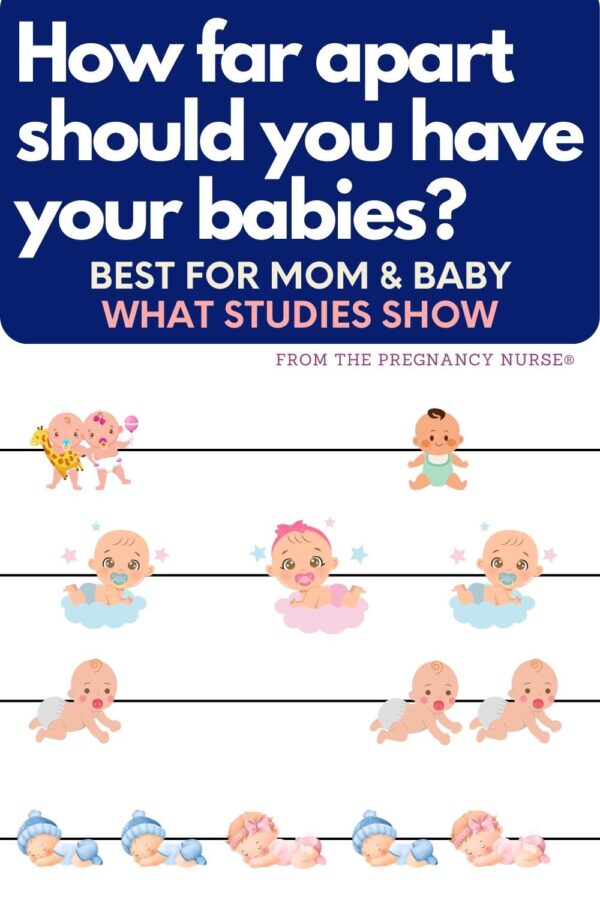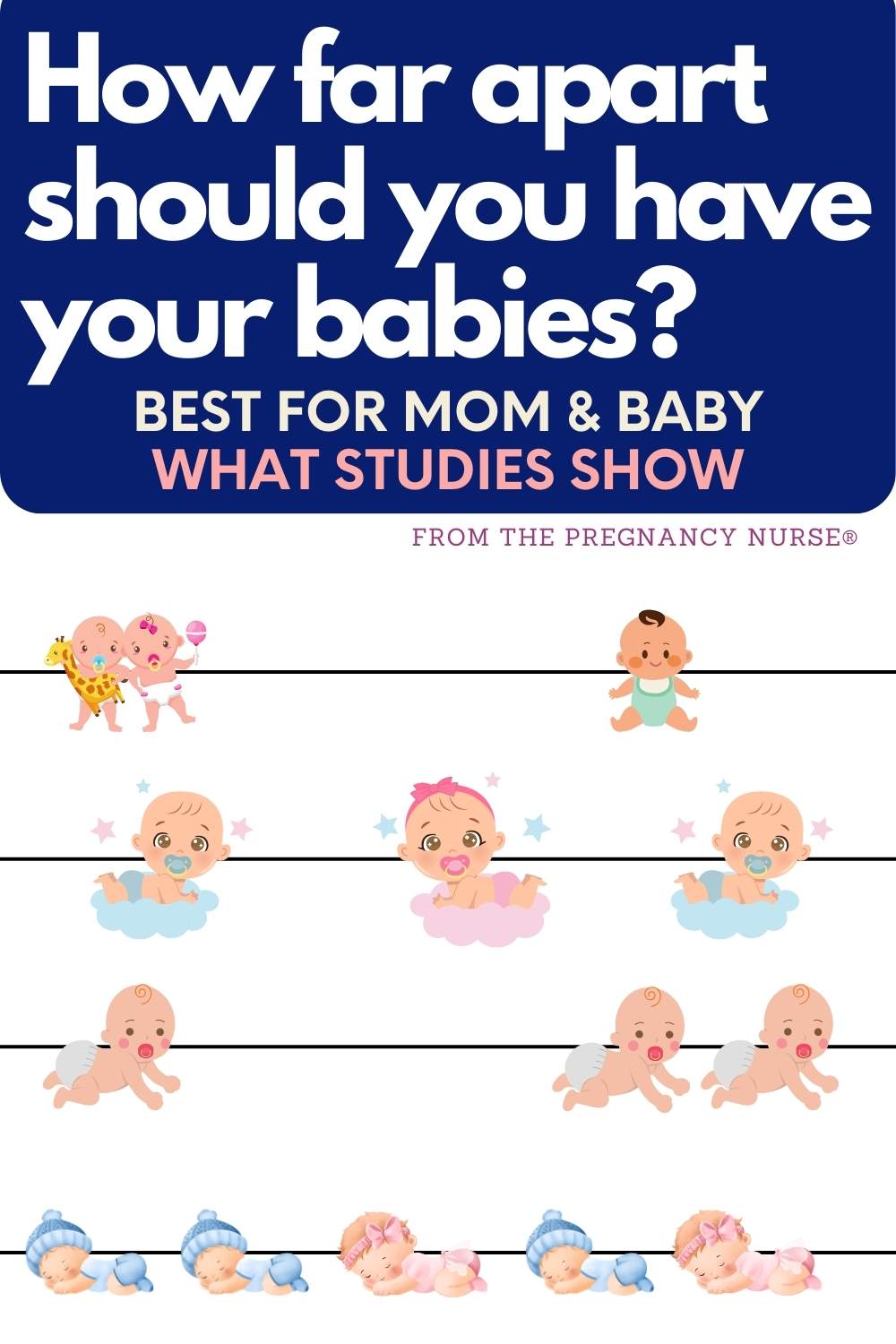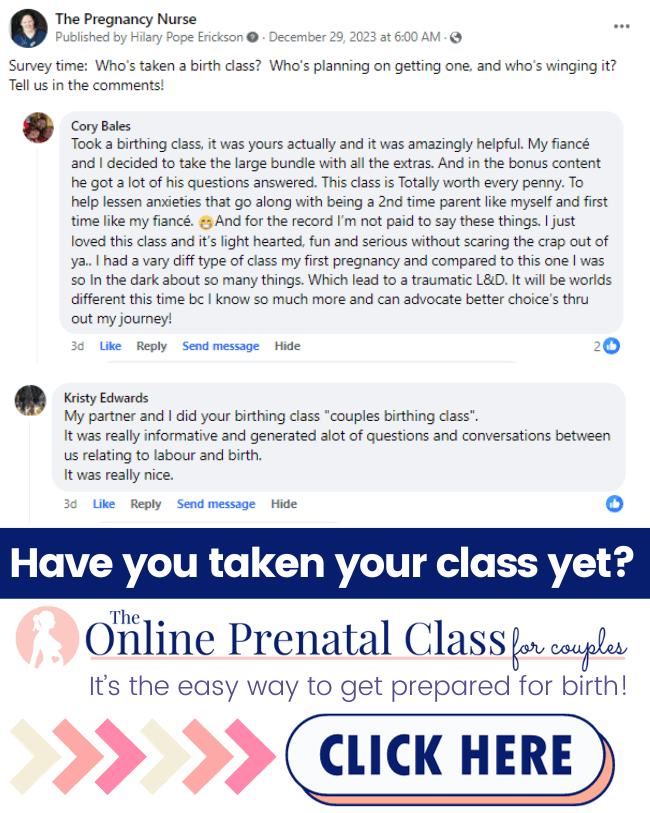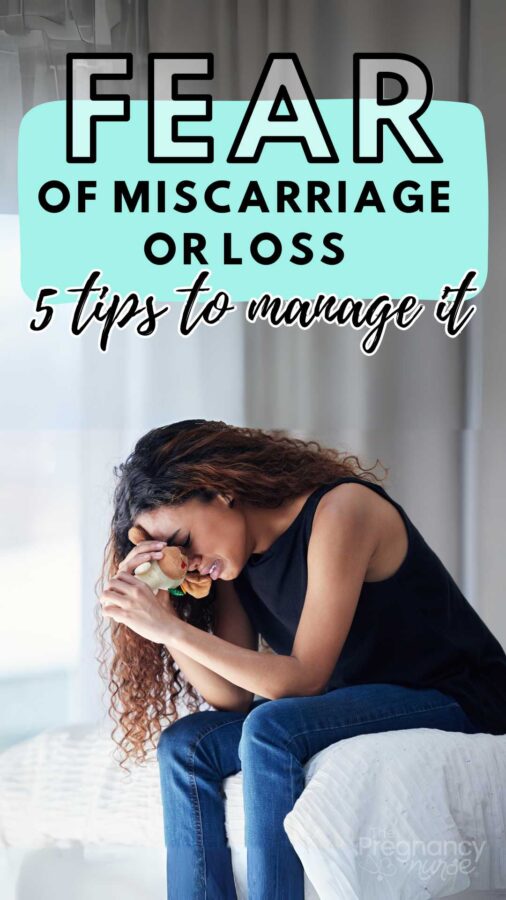You’re thinking about another baby — and it’s definitely smart to think about. Beyond daycare and other monetary costs, emotional costs of adding another family member there is a cost to mom’s body. Today we’re going to talk about what science shows is best as a spacing interval to at least give you some guidance as you make this tough choice. We will also be discussing how this relates if you’ve previously had a miscarriage — so keep reading.

This (or any article on The Pregnancy Nurse) should be taken as medical advice, this purely educational. Please talk with your provider about your specific needs and circumstances.
Note: Every family is different. I very much understand that a lot of people are “under the gun” if declining fertility and increase health risks to mom the longer you wait to get pregnant again. I am only here to present what the studies say, to give you a baseline idea as you discuss your next pregnancy with your provider. That all has to be balanced, and is best done with your own, individual provider. However, looking at the studies is smart to do on your own, so you’re not coming in blind.
Every family is different, no choice looks the same — so remember that as you read this article.
I have a whole article on my parenting site based entirely on emotion and what I’ve seen in other families you might also find helpful.
I also want to say that not everyone gets to “choose” their baby spacing. I wanted all of my kids much closer together, but infertility made that not happen. That isn’t what this article is about — it’s more about when you should start to “try again” — and then mother nature does her thing.
We’re also basing this entirely on health outcomes, not any effects (like mental or emotional) for babies/siblings as they age (although if you’re interested in this, I thought this article was helpful — it showed poor outcomes for both very short intervals and very long ones as well).
And, if you’re a pregnant friend — grab my 3rd trimester checklist that comes with SO many awesome resources:
Optimal Spacing for Healthy Babies
Here is a few basic findings:
This one showed that 18-23 months provides the “ideal conditions” for a healthy pregnancy. Babies conceived within six months of delivery had a 40% higher chance of being premature or undersized compared to those who waited 18-23 months. It ALSO showed that people who waited 10 years+ were twice as likely to have a small for gestational age baby (SGA), and were 50% more likely to give birth prematurely.
Pro tip: It’s important to look at if studies are talking from birth to conception, or birth to DELIVERY. Many doctors say to wait 2 years to have a baby, but they mean to aim the next delivery to 2 years after your last one — meaning you could conceive about 15 months after delivery.
ACOG (the American College of Obstetrics and Gynecology — the governing board of OB in the US) recommends waiting at least 6 months to conceive. They recommend that patient be counseled on the risks and benefits of waiting 18 months or more to get pregnant again. They have a few studies they site and ultimately say:
- Intervals of less than 18 months after a cesarean have shown an increase in uterine rupture
- Intervals of greater than 5 years can have adverse outcomes
This study tested these theories based on mom’s age at conception. However, they didn’t really find big differences based on the mom’s age (they do show some differences but ultimately concluded the risks were similar regardless of your age). Risk of preterm delivery for those who had less than a 6 month birth to conception date was increased across the board (although a bit less in those over 35).
They took their results to conclude that those who are looking to have their babies closer together, and are older may be safer to do so than those who are younger. Although, they don’t particularly have an explanation for why. You can read more about their explanations in this article.
This study showed an increase risk of stillbirth with intervals less than 6 months. Although they said there may be a variety of factors in play with that, and the increased risk was small.
This one showed that if you’ve had a previous preterm birth it is recommended to wait at least 9 months to decrease your risk next time.
Want to know more about having more babies — check out these posts:
- Reason You’ll Want a Birth Class on Your Second+ Baby
- The Fear of Miscarriage or Loss
- 5 Things That Are Different on Your Second+ Baby
- Second Baby Checklist: Preparing for the NEXT baby.
- How to Fit In A Birth Class
Application of these Studies:
Now we get to sort of guess as to why these might be true — and apply them to you and your needs. Here’s a few things to think about:
Did you have a cesarean?
If you previously had a cesarean, it does stand to reason that increasing your time of healing between pregnancies allows for a healthier baby and not having your uterus rupture (a big complication of post-cesarean pregnancies). This study showed that less than 6 months had the greatest chance of uterine rupture (and frankly — it was a lot higher, so that’s really something to consider).
In the case of a previous cesarean birth — I think most providers recommend at least 18 months between conception to conception, and they prefer closer to 24 months. If you’re wanting to VBAC, this especially makes sense.
Want to know more about cesarean births — check out these posts:
- C-Section Recovery: Tips You’ll Need
- Considering a VBAC: What to do
- What to Wear For a Cesarean Section
- How to Prepare for Your C-Section (Cesarean Section)
- C-Section Scar Pain During Early Pregnancy
Are you on a “ticking clock” for fertility?
If you feel like you need to have those babies faster for everyone’s health, that study showed that maybe you were safer if you’re over 35.
Personally, I likely guess that’s due to a higher socioeconomic level for people having babies later in life. They tend to have better insurance, better access to prenatal care and eating the right foods for the best health. However, we can’t be sure.
I will say that I don’t see a lot of studies looking more at a 1-year interval. Most seemed to focus on comparing 6 months to 18 months, but maybe a year is enough. A good question for your provider (as they can base it off you and your specific medical needs).
Why might longer intervals be safer?
So, why might waiting be better for you and baby?
Nutritional Depletion: That baby will take from you whatever it needs, so if you don’t have as much time to “shore up your reserves” — to eat a great diet and replenish what has been taken it might be harder for the second baby. They won’t have as much to work with.
Grab my safe eating guide to make sure you’re eating the right foods:
Damage to your Reproductive System: Your uterus grows and shrinks a lot during pregnancy & postpartum, so allowing your whole system to heal for a bit does seem smart.
Postpartum Stress: If you’ve already had a baby I am here to tell you it’s stressful to add a baby to your family. That stress takes a toll on your body, so you should plan on being kind to it.
Some other sources say that it allows you to bond better with your baby as well (although I don’t see any studies on that).
However, you have to remember that people who conceive less than 6 months after their last baby are often doing so un-planned. That means they have less prenatal care early on compared to those who wait. Most often I see these as “oops” babies — often conceived before mom even gets her period back and isn’t paying attention to that issue.
That’s clearly different than those who plan to have babies very close together and will hopefully get the same prenatal care as they did the first time.
I gotta say a lot of second+ time moms are carrying around a lot of birth trauma. Which isn’t doing anyone any good.
I definitely had that on my second baby — I was so worried about things going wrong again and me having a horrible recovery — until I found this.
It prepares you for the rest of your pregnancy, labor, birth, and postpartum (thank GOODNESS for the postpartum section). It really will get you prepared.
Effects on Mom?
I will say that I felt there was a gap in coverage on effects to mom’s health in baby’s spacing. Are there increases in postpartum complications when babies are closer together?
We spend so much time focusing on outcomes for the baby — I wish we did more about effects on mom.
This one showed some issues like “maternal nutritional depletion, folate depletion, cervical insufficiency, vertical transmission of infections, suboptimal lactation related to breastfeeding-pregnancy overlap, sibling competition, transmission of infectious diseases among siblings, incomplete healing of uterine scar from previous cesarean delivery, and abnormal remodeling of endometrial blood vessels.”
I did see some stuff on folate levels really taking a while to ramp back up after delivery — and I think that’s something we should consider (but effects baby more than mom, most likely).
Does this apply to Miscarriage?
I often get asked if this same thing applies to miscarriages, and doesn’t seem to.
This study showed conception of less than six months between miscarriage and conception had the best reproductive outcome and the lowest complication rates.
This one showed there really wasn’t a difference based on how long between (including abortions as well).
This one showed waiting less than 3 month showed the lowest risk for subsequent miscarriages.
All of them showing that you did NOT need to wait between miscarriages to try to conceive again.
It makes sense, if it’s an early loss (so these would be prior to 20 weeks) your uterus and body hasn’t had all the effects on it as carrying a baby to full term.
However, if you’ve had a loss after 20 weeks you may consider waiting like we had talked about above. Definitely a discussion to have with your provider based on your past obstetrical history.
Also, if you’re having frequent losses you definitely want to get with your provider to see if you can find an issue for it, at least check basic labs to make sure all are normal.
Conclusion:
After reading all of these studies it really makes sense to wait at least 6 months to get pregnant again. As someone who’s had children I really think it takes time for your body, and your mind (and your pocketbook) to heal after having a baby.
It was interesting that longer intervals showed larger issues — that may be due to maternal age, it’s hard to say.
Ultimately, you have to decide what’s best for you — and then do as much as you can to promote a healthy pregnancy depending on when you do get pregnant. Including:
- Getting good prenatal care (so hard to get appointments in with a small baby in tow as well — I get that!)
- Eating as well as possible, and making sure to take prenatal vitamins (and possibly even more — like choline or higher levels of folate if you discuss it with your provider or nutritionist)
- Taking appropriate self-care measures including stress relief and working out to make sure your body is as healthy as you can make it.
- Watching for signs of preterm labor, at a recent conference they talked a lot about cervical length and this may be something you want to discuss with your provider. Preterm labor is one of your biggest risks, so it’s important to know the signs.
Many of you may be thinking SIX MONTHS — NO WAY! I think it’s also valid to wait until you feel ready. No shame in that either. Increasing your family size isn’t something that should be taken lightly, so I’m glad you are considering both you and your baby’s health in regards to this issue.
AND if you’re pregnant right now, I would like to make sure that you’re taking a birth class. Even if it is your second babies studies have shown huge benefits to taking a high quality class including:
- Decreased c-section rates
- Decreased induction rates
- Decreased assisted delivery rates (like forceps or vacuums
- Increased birth satisfaction due to your preparation.
I recommend this one.
Sources:
Gottlieb S. Research shows optimal spacing for healthy babies. BMJ. 1999 Mar 6;318(7184):624A. doi: 10.1136/bmj.318.7184.624a. PMID: 10066193; PMCID: PMC1115082.
Schummers L, Hutcheon JA, Hernandez-Diaz S, Williams PL, Hacker MR, VanderWeele TJ, Norman WV. Association of Short Interpregnancy Interval With Pregnancy Outcomes According to Maternal Age. JAMA Intern Med. 2018 Dec 1;178(12):1661-1670. doi: 10.1001/jamainternmed.2018.4696. PMID: 30383085; PMCID: PMC6583597.
Stamilio DM, DeFranco E, Paré E, Odibo AO, Peipert JF, Allsworth JE, Stevens E, Macones GA. Short interpregnancy interval: risk of uterine rupture and complications of vaginal birth after cesarean delivery. Obstet Gynecol. 2007 Nov;110(5):1075-82. doi: 10.1097/01.AOG.0000286759.49895.46. PMID: 17978122.
Love ER, Bhattacharya S, Smith NC, Bhattacharya S. Effect of interpregnancy interval on outcomes of pregnancy after miscarriage: retrospective analysis of hospital episode statistics in Scotland. BMJ. 2010 Aug 5;341:c3967. doi: 10.1136/bmj.c3967. PMID: 20688842; PMCID: PMC2917004.
Tessema GA, Håberg SE, Pereira G, Magnus MC. The role of intervening pregnancy loss in the association between interpregnancy interval and adverse pregnancy outcomes. BJOG. 2022 Oct;129(11):1853-1861. doi: 10.1111/1471-0528.17223. Epub 2022 Jun 1. PMID: 35596254; PMCID: PMC9541236.
Sundermann AC, Hartmann KE, Jones SH, Torstenson ES, Velez Edwards DR. Interpregnancy Interval After Pregnancy Loss and Risk of Repeat Miscarriage. Obstet Gynecol. 2017 Dec;130(6):1312-1318. doi: 10.1097/AOG.0000000000002318. PMID: 29112656; PMCID: PMC5709156.
Conde-Agudelo A, Rosas-Bermudez A, Castaño F, Norton MH. Effects of birth spacing on maternal, perinatal, infant, and child health: a systematic review of causal mechanisms. Stud Fam Plann. 2012 Jun;43(2):93-114. doi: 10.1111/j.1728-4465.2012.00308.x. PMID: 23175949.
Wendt A, Gibbs CM, Peters S, Hogue CJ. Impact of increasing inter-pregnancy interval on maternal and infant health. Paediatr Perinat Epidemiol. 2012 Jul;26 Suppl 1(0 1):239-58. doi: 10.1111/j.1365-3016.2012.01285.x. PMID: 22742614; PMCID: PMC4562277.
Birth spacing and risk of adverse pregnancy and birth outcomes: A systematic review and dose–response meta-analysis Wanze Ni, Xuping Gao, Xin Su, Jun Cai, Shiwen Zhang, Lu Zheng, Jiazi Liu, Yonghui Feng, Shiyun Chen, Junrong Ma, Wenting Cao, Fangfang Zeng








 Your Complete Guide to Epidurals in Labor: Everything You Need to Know
Your Complete Guide to Epidurals in Labor: Everything You Need to Know
